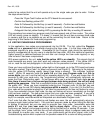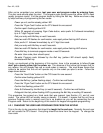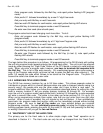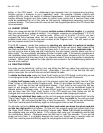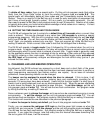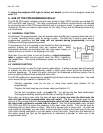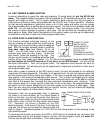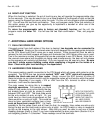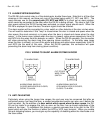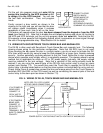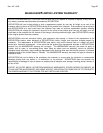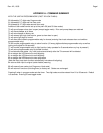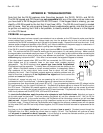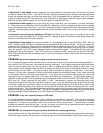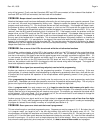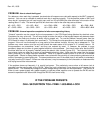Rev. A.2, 10/03 Page-iv
entry will be ignored. Finally note that if terminals SRC and UCD are connected, all User codes will be disabled. If
terminals SRC and HCD are connected, the Hard code will be disabled.
PROBLEM-- Beeper doesn’t sound while the unit otherwise functions
Note that the beeper could have been deliberately silenced by the unit having been sent a special command. Even
on a new unit, this could have happened by factory error. Attempt to restore the beeper by putting the unit into
program mode and entering 7-2. You should see the two red flash confirmation. If the beeper still doesn’t work,
the problem is either a wiring mistake, a defective beeper or a fault on the CPU board with the output that drives
the beeper. Check that the keypad blue wire (this controls the beeper) is connected into terminal BLU. If it is, next
remove it from the BLU terminal and briefly touch it to terminal DC-. If the beeper sounds, the problem is with the
beeper driver on the CPU board and the CPU board will have to be replaced. If the beeper does not sound, the
problem is with the beeper itself in the keypad or with the internal beeper wiring within the keypad. The beeper is
the only part of the keypad which is repairable. This is because the beeper is physically located in a chamber at
the bottom of the keypad. If it was sealed in the keypad, the sound level would not be adequate. Look at the
beeper in its chamber to confirm that the wires look OK. You can then return the keypad to the factory for beeper
replacement or you can replace the beeper in the field (this requires soldering). The part number for a replacement
beeper from Securitron is 050-10600.
PROBLEM-- One or more of the LED’s do not work while the unit otherwise functions
This is either a wiring mistake, a failed LED in the keypad or a fault on the CPU board with the output that drives
the LED. Each LED is operated by the wire that bears the LED’s color. So, for example, if the green LED is the
one that is not working, first check to see that the green keypad wire is correctly connected to terminal GRN. . If it
is, next remove it from the GRN terminal and briefly touch it to terminal DC-. If the green LED comes on, the
problem is with the driver on the CPU board and the CPU board will have to be replaced. If the LED does not
come on, the problem is with the LED in the keypad or with the internal wiring within the keypad. The keypad will
have to be replaced to restore operation of the LED.
PROBLEM-- Error signal (one second long red pulse) received while programming
Anytime you receive an error signal, retry the programming operation. It’s easy to mis-hit one key. If the error
signal persists, it is almost always a misunderstanding of programming procedures rather than a fault with the unit.
A product fault that impaired the operation of the microprocessor would generally prevent it from giving you the
error signal.
When programming the hard code, you directly enter the code once you are in hard programming mode (slow
yellow flash). Remember you must never pause for more than five seconds while pressing keys. The only way to
get an error signal while programming the hard code is to enter an illegal one digit code.
When in program mode, the most common error is to forget to enter the two digit memory slot prefix when
attempting to program a code. Valid prefixes are 00-59 and if this step is forgotten in an attempt to enter the code
directly, there are a lot of sequences that will create an error signal. For example, any sequence that starts with 6
will be rejected. 8-5 is also illegal. Or if you entered just 9-2, the unit would read 9 as an attempt to change the
door open time and then reject a single digit new time.
Another source of the error signal would be an illegal attempt to enter a program code of less than five digits
(after prefix 0-0). Finally, while programming multiple codes, you will get an error signal if a code you’re attempting
to program is a subset of one already in memory or a duplicate (see Section 4.4).
PROBLEM-- Door opens on a short code that wasn’t programmed
This can arise through an unnoticed programming error. Suppose you want to program 4-5-1-2. But when the unit
is in program mode, you forget to put in the two digit memory slot prefix but just directly enter 4-5-1-2. The
microprocessor will accept this sequence and interpret it as code 1-2 in memory slot 45. You test the code by re-
entering 4-5-1-2 and the door opens because the sequence includes the real code, 1-2. Later it will be noticed that
the door is opening on 1-2 as this is such a simple sequence that it will be entered. When you have any evidence
that unknown codes (particularly short ones) are in the unit, it is best to erase all User codes and reprogram.



